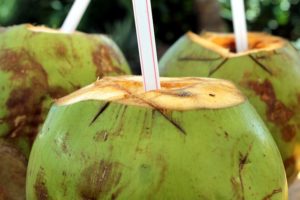 Are you ready for more about coconut?
Are you ready for more about coconut?
Last week, we talked about coconut nutrition, coconut oil and coconut milk, and shared a variety of nutritious and delicious meal ideas!
This week, for part 2, we want to continue the discussion on some of the other coconut products you will see on the store shelves.
Coconut water?
 You guessed it…this is the clear liquid found inside – you can hear it when you shake the coconut. An average coconut has about 1/2 to 1 cup of water inside.
You guessed it…this is the clear liquid found inside – you can hear it when you shake the coconut. An average coconut has about 1/2 to 1 cup of water inside.
If you read last week’s coaching tip, you know this is different than coconut milk (which is a blend of grated coconut meat and water). In its natural state, coconut water has about 50 calories per 8 oz serving and around 10 grams of natural sugar. It can be good for hydration since it has electrolytes, including potassium and some people describe it as having a lightly sweet, refreshing flavor.
Keep in mind, some coconut waters have been sweetened up with added sugars or fruit juices – as always, make sure to read those ingredient labels. If you like the taste of coconut water, it can be a good choice once in a while (especially compared to Gatorade and other sports drinks), but plain ol’ water will always be the best choice for your day-to-day hydration (or try our Fruit Infused Water!).
Creamed coconuts?
Brace yourself…here is where it gets a little confusing. There is coconut cream, cream of coconut and creamed coconut. Now for the breakdown:
 Coconut cream. We talked about this in last week’s coaching tip. This is made from the liquid of grated coconut meat, using the same process that produces coconut milk. It is thicker and has a higher coconut to water ratio compared to coconut milk. It can be used as a substitute for dairy cream or half and half, and can even be used to make your own whipped cream. It also works well in curries, soups, smoothies and other desserts like the Coconut Cream Tiramisu.
Coconut cream. We talked about this in last week’s coaching tip. This is made from the liquid of grated coconut meat, using the same process that produces coconut milk. It is thicker and has a higher coconut to water ratio compared to coconut milk. It can be used as a substitute for dairy cream or half and half, and can even be used to make your own whipped cream. It also works well in curries, soups, smoothies and other desserts like the Coconut Cream Tiramisu.
- Cream of coconut. If you have ever had a Pina Colada, you have probably had cream of coconut. Think of it as highly sweetened coconut cream with a syrupy consistency. It’s a little like sweetened condensed milk and is often used in all kinds of desserts and tropical drinks. Just 2 Tbsp of cream of coconut contains 17 grams (or more!) of added sugar…that’s over 4 teaspoons! As you can imagine, we don’t have any recipes on the website that use cream of coconut!
 Creamed coconut. You may not be as familiar with creamed coconut. Its name is a little misleading because it is actually in the form of a solid block when you buy it. It is made from ground and dehydrated coconut meat, which is formed into a paste and then hardened at room temperature. This block is typically packaged in airtight plastic pouches before being shipped to stores. Creamed coconut is actually very versatile. For a more intense coconut flavor, chop it up and add it to dishes like curries, soups or smoothies. It can also quickly turn into coconut milk or coconut cream! For coconut milk, mix 1 Tbsp creamed coconut with 5 Tbsp hot water and stir briskly until it is fully dissolved and the liquid resembles coconut milk. For coconut cream, do the same thing, using 2 Tbsp creamed coconut for every 5 Tbsp of hot water. Many stores carry creamed coconut (we found it locally at Natural Grocer) and you can also find it on Amazon (of course!). A couple of great recipes to enjoy creamed coconut include the Creamy Fruit Salad and the Thai Shrimp Curry with Spaghetti Squash.
Creamed coconut. You may not be as familiar with creamed coconut. Its name is a little misleading because it is actually in the form of a solid block when you buy it. It is made from ground and dehydrated coconut meat, which is formed into a paste and then hardened at room temperature. This block is typically packaged in airtight plastic pouches before being shipped to stores. Creamed coconut is actually very versatile. For a more intense coconut flavor, chop it up and add it to dishes like curries, soups or smoothies. It can also quickly turn into coconut milk or coconut cream! For coconut milk, mix 1 Tbsp creamed coconut with 5 Tbsp hot water and stir briskly until it is fully dissolved and the liquid resembles coconut milk. For coconut cream, do the same thing, using 2 Tbsp creamed coconut for every 5 Tbsp of hot water. Many stores carry creamed coconut (we found it locally at Natural Grocer) and you can also find it on Amazon (of course!). A couple of great recipes to enjoy creamed coconut include the Creamy Fruit Salad and the Thai Shrimp Curry with Spaghetti Squash.
 Coconut butter?
Coconut butter?
Coconut butter is essentially the same as creamed coconut. It is made using the same process and is solid at room temperature.
If you want an idea to try coconut butter (or creamed coconut), check out our REAL Rice Krispie Treats and Polar Peppermint Bites.
Coconut sugar?
 Coconut sugar is made from the sap of coconut palm flowers. The process of removing the sap is similar to how maple syrup is extracted from maple trees. This sap is then cooked down into a brown syrup and turned into crystalized coconut sugar. Many say it has a flavor similar to brown sugar with a hint of caramel. It does not taste like coconut at all.
Coconut sugar is made from the sap of coconut palm flowers. The process of removing the sap is similar to how maple syrup is extracted from maple trees. This sap is then cooked down into a brown syrup and turned into crystalized coconut sugar. Many say it has a flavor similar to brown sugar with a hint of caramel. It does not taste like coconut at all.
Coconut sugar has a lower glycemic load versus refined table sugar and doesn’t spike blood sugars quite as high. Also, because it isn’t refined the same way as other sugars, it does retain some of its natural nutrients (although it is not a significant source of vitamins, minerals or antioxidants).
In the end, remember, coconut sugar is still sugar! It can be a good alternative to refined white or brown sugar but, as with all sugar and sweeteners, it is best enjoyed in moderation. It works perfectly in sweet and savory dishes like the Black Dream Chocolate Cupcakes, Chocolate Chip Banana Bread, Mocha Chocolate Chip Muffins, Easy Pumpkin Pancakes, Spiced Middle Eastern Butternut Squash and the Bulgogi.
Coconut flour?
 Coconut flour is made by processing dried coconut meat into a flour. Often, the coconut meat that is leftover after making coconut milk is used to make coconut flour. It has a soft, powdery texture, and has a slight coconut flavor and aroma. Of course, it is gluten free.
Coconut flour is made by processing dried coconut meat into a flour. Often, the coconut meat that is leftover after making coconut milk is used to make coconut flour. It has a soft, powdery texture, and has a slight coconut flavor and aroma. Of course, it is gluten free.
It’s important to know that coconut flour doesn’t cook the same as other flours like whole wheat flour. This is primarily because it doesn’t contain starch like other flours do. It also tends to absorb more liquid compared to other flours. If you are wanting to use coconut flour as a replacement for other flours when baking, it is probably best to limit it to no more than 20% of the recipe. You may also need to increase your liquid by the same amount of coconut flour you are adding (or add one egg for every 1/4 cup of coconut flour).
Coconut flour can be a good option when you are using it as a breading or to help thicken sauces, soups or stews. Some recipes where it could be a good addition include the Baked Chicken Pesto Parmesan, Portobello Stroganoff, Gumbo with Chicken & Sausage, Veggie Skillet Lasagna and the Baked Onion Rings.
Coconut aminos?
 The same sap that is used to make coconut sugar can also be used to make coconut aminos. Basically, the sap is fermented, and then blended with sea salts. It can be used similar to soy sauce, although it often has a lighter color and is slightly milder and sweeter than soy sauce. Just like coconut sugar, it does not taste like coconuts at all.
The same sap that is used to make coconut sugar can also be used to make coconut aminos. Basically, the sap is fermented, and then blended with sea salts. It can be used similar to soy sauce, although it often has a lighter color and is slightly milder and sweeter than soy sauce. Just like coconut sugar, it does not taste like coconuts at all.
If you are watching your sodium, coconut aminos have about 1/3 the amount of sodium compared to soy sauce. For example, we looked at our local store and the coconut aminos had 90 mg of sodium per tsp (vs 320 mg per tsp in the soy sauce…even the lite soy sauce had 210 mg per tsp). So, while it is “lower” in sodium, it is still not a “low” sodium food. And, if wheat or gluten are a concern, coconut aminos can be a good choice because they typically do not contain these ingredients. Like everything, read the ingredient labels because some coconut aminos do contain added sugars. Some good recipe ideas include the Kung Pao Chicken Lettuce Wraps, Thai Basil Beef Skillet, Chicken Terriyaki Burger and the Honey Lime Sriracha Cauliflower.
We hope this helps make the world of coconut and coconut products a little less confusing!
Do you use these coconut products or have tips that could help our Eat REAL America members?
 LEARN MORE ABOUT THE NAPKIN!
LEARN MORE ABOUT THE NAPKIN!



Yes, coconut nature water is very helpful the pregnancy. They drink coconut juice when the baby around 4 months and up to the time ready to born. The juice is help the baby born fast without so much of pain, clean and smooth skin. When I pregnant 3 of my children, my mother advised me to drink at least 1 a day the fresh coconut juice cut down from the tree. I was in the concentration camp when I pregnant my daughter so I didn’t have a chance to drink that early until the 7 months. I can see the different feeling between my daughter and other 2 boys when they were born. Also, coconut fruits are very popular and cheap in Vietnam. I haven’t try to cook with the coconut oil yet because we used a lot of peanut oil. again, peanuts are cheaper in Vietnam back 1900’s (my age)
I hope that you understand what I shared.